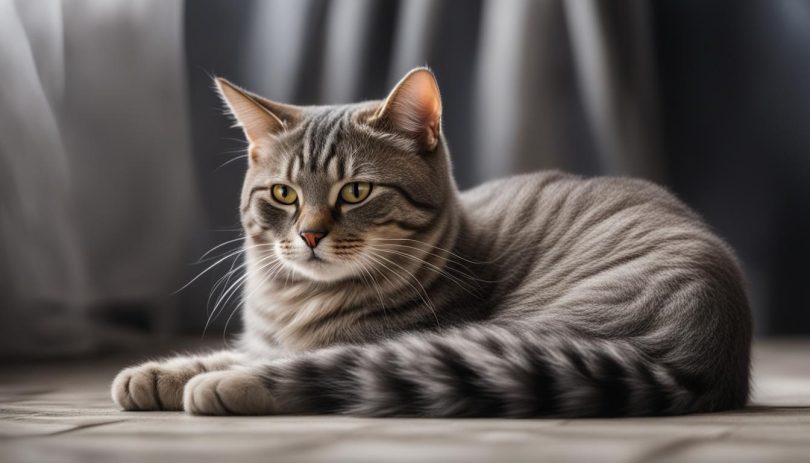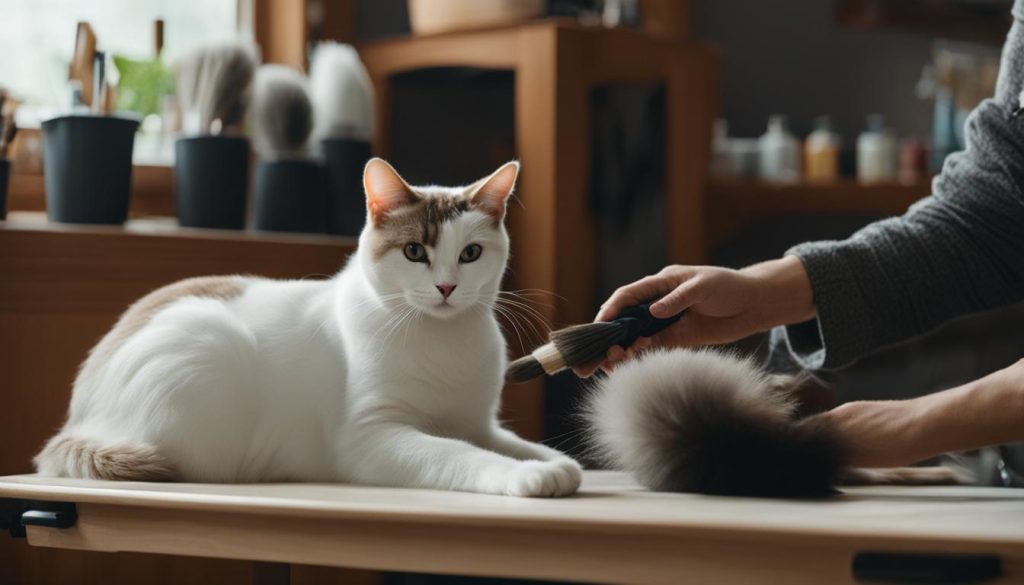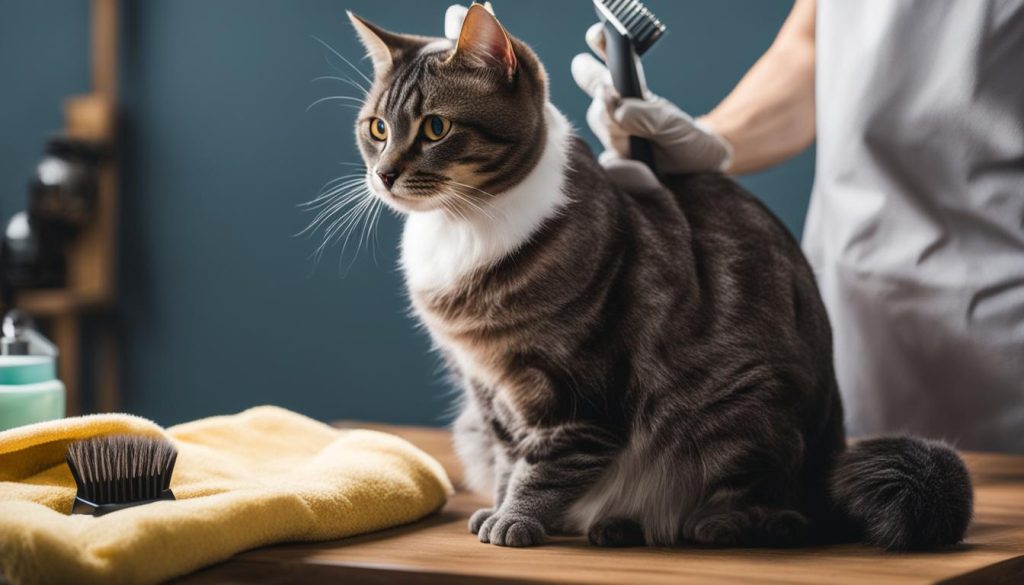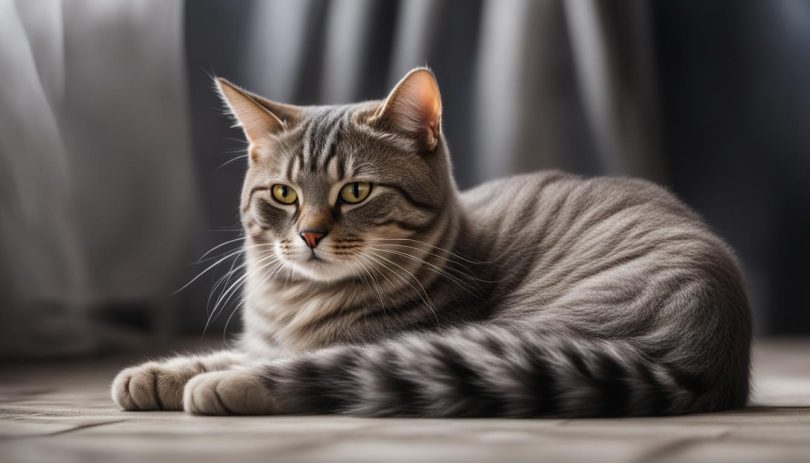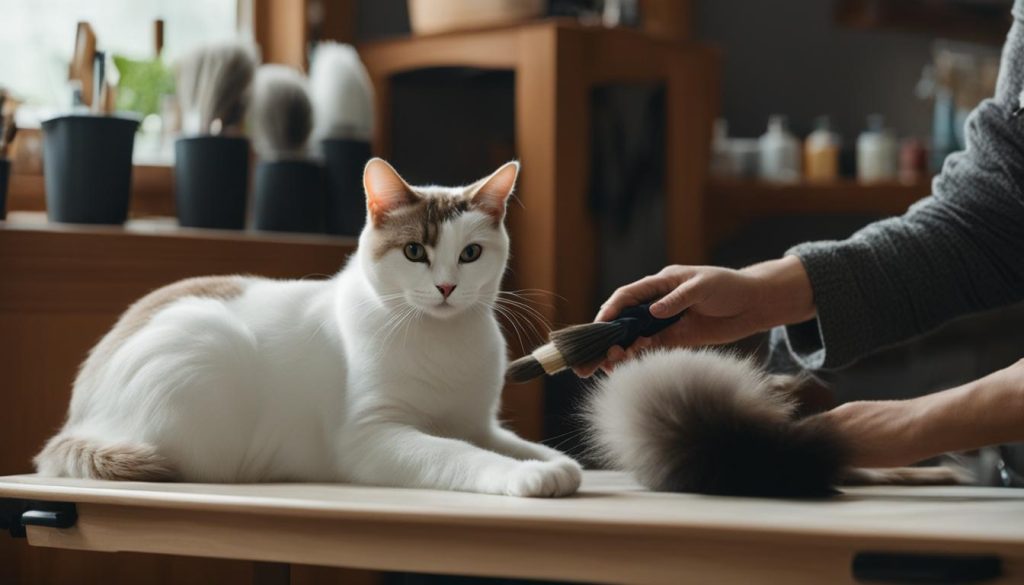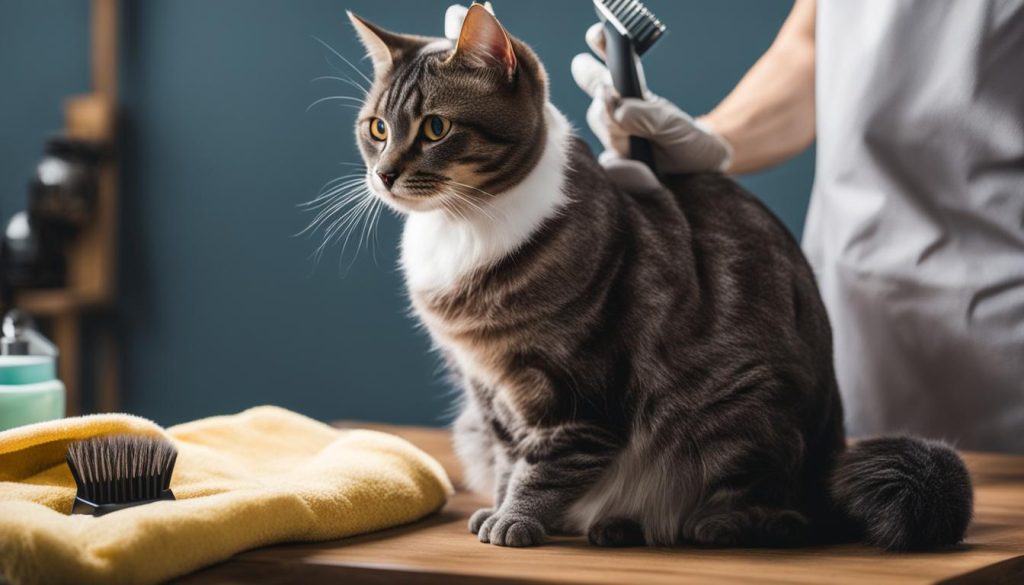As a cat owner, I understand the frustration of dealing with European Shorthair shedding. It seems like no matter how much I clean, there’s always another furball lurking in the corner. But fear not, because I’ve done my research and I’m here to share my findings on why European Shorthairs shed and how you can manage it.
Key Takeaways
- European Shorthair shedding is a common concern for cat owners.
- Factors such as seasons and hormonal changes can affect shedding patterns.
- Regular grooming, a balanced diet, and a clean environment can help reduce shedding.
- Consulting with a veterinarian is important if you notice excessive hair loss or bald patches.
- Promoting a healthy coat in European Shorthairs involves grooming, nutrition, and a stress-free lifestyle.
Factors Affecting European Shorthair Shedding
Shedding in European Shorthairs can be influenced by various factors, including changes in seasons and hormonal fluctuations. European Shorthairs tend to have a heavier shedding season in the spring as they prepare for warmer weather. This shedding season, known as the European Shorthair shedding season, is a natural process for the breed. During this time, their coat may shed more to make way for a lighter summer coat. It is important to note that shedding can vary between individual cats, so not all European Shorthairs may experience the same level of shedding during this season.
Hormonal changes can also affect shedding patterns in European Shorthairs. For example, female cats may experience increased shedding during pregnancy or after giving birth. Male cats that have been neutered may also have changes in their shedding patterns. These hormonal fluctuations can cause temporary shifts in the amount of fur that is shed. It is important to anticipate and manage these changes to ensure your European Shorthair’s coat remains healthy and free of excess fur.
To reduce shedding in European Shorthairs, it is recommended to provide regular grooming and maintenance. This includes brushing your cat’s coat at least once a week to remove loose fur and prevent it from spreading throughout your home. During the shedding season, you may need to increase the frequency of brushing to keep up with the amount of fur being shed. Additionally, providing a healthy diet that is rich in essential fatty acids can support a healthy coat and reduce shedding. Consult with your veterinarian for specific dietary recommendations for your European Shorthair.
| Factors Affecting European Shorthair Shedding | Solutions |
|---|---|
| Seasonal Changes | Regular grooming and brushing to manage shedding |
| Hormonal Fluctuations | Anticipate and manage changes in shedding patterns |
| Regular Grooming | Brushing your European Shorthair’s coat to remove loose fur |
| Healthy Diet | Provide a balanced diet rich in essential fatty acids |
“Understanding the factors that contribute to shedding in European Shorthairs can help you anticipate and manage shedding in your pet. By providing regular grooming, a healthy diet, and being aware of seasonal and hormonal changes, you can help keep your European Shorthair’s coat healthy and minimize excess fur in your home.”
Grooming Techniques for Managing European Shorthair Shedding
As a proud owner of a European Shorthair, you may be wondering how to effectively manage their shedding. Thankfully, there are several grooming techniques and tips that can help keep your cat’s coat in top shape and minimize shedding.
Regular Brushing: A Key to Success
One of the most important grooming techniques for managing European Shorthair shedding is regular brushing. By brushing your cat’s coat at least once a week, you can effectively remove loose fur and prevent it from spreading throughout your home. Use a grooming brush that is suitable for your cat’s coat length and texture. Start by gently brushing the fur in the direction it naturally grows, paying extra attention to areas where shedding is more prominent, such as the belly and back.
Bathing for Extra Shedding Control
In addition to regular brushing, bathing your European Shorthair can also help reduce shedding. Giving your cat a bath every few months using a gentle cat shampoo can remove dead skin cells and excess oil, which can contribute to shedding. Make sure to rinse the shampoo thoroughly and dry your cat completely after the bath to avoid any discomfort or chill. If your cat is not accustomed to bathing, start with short and positive grooming sessions to gradually introduce them to the experience.
Investing in Deshedding Tools
If shedding remains a concern despite regular brushing and bathing, consider investing in deshedding tools specifically designed for European Shorthairs. Deshedding combs or brushes can help remove the loose undercoat, which is often the primary cause of shedding. These tools are designed to reach the deeper layers of fur and can be highly effective in minimizing shedding. However, always use them gently and with caution to avoid any discomfort or skin irritation.
By following these grooming techniques and tips, you can effectively manage European Shorthair shedding and maintain a clean and fur-free home. Remember, each cat is unique, and it’s essential to adapt your grooming routine to their specific needs and preferences. Regular grooming not only controls shedding but also promotes a healthy coat and strengthens the bond between you and your feline companion.
Best Cat Food for Reducing European Shorthair Shedding
When it comes to managing European Shorthair shedding, providing a balanced and nutritious diet is essential. The right cat food can play a significant role in promoting a healthy coat and reducing excessive shedding. Look for cat food formulas that are specifically designed to support skin and coat health.
A key factor to consider in the best cat food for reducing European Shorthair shedding is the inclusion of essential fatty acids, such as omega-3 and omega-6. These fatty acids are known to nourish the skin and coat, helping to maintain their health and reduce shedding. High-quality cat food brands often include these essential fatty acids in their formulas.
“A balanced and nutritious diet is essential for promoting a healthy coat and reducing shedding.”
When selecting cat food for your European Shorthair, look for formulas that prioritize skin and coat health. These formulas usually contain ingredients such as fish oil, flaxseed, or chicken fat, which are rich sources of essential fatty acids. Additionally, they may also include ingredients like biotin or zinc, which further support coat health and reduce shedding.
| Key Ingredients | Purpose |
|---|---|
| Fish Oil | Rich in omega-3 fatty acids to promote a healthy coat |
| Flaxseed | Source of omega-3 fatty acids for skin and coat health |
| Chicken Fat | Provides omega-6 fatty acids for a shiny coat |
| Biotin | Supports healthy skin and coat |
| Zinc | Helps maintain a healthy coat and reduce shedding |
Remember to consult with your veterinarian before making any changes to your cat’s diet. They can provide guidance on the best cat food options for your European Shorthair’s specific needs and help you choose a formula that supports their overall health and reduces shedding.
Tips to Reduce European Shorthair Shedding
Reducing shedding in your European Shorthair can help keep your home cleaner and your pet more comfortable. Here are some tips to help you minimize shedding:
- Regular brushing: Brush your European Shorthair’s coat at least once a week to remove loose fur and prevent it from spreading throughout your home. Use a brush specifically designed for shedding cats to effectively remove the excess fur.
- Balanced diet: Feed your cat a high-quality cat food that is rich in essential fatty acids, such as omega-3 and omega-6. These nutrients promote a healthy coat and can reduce excessive shedding. Consult with your veterinarian to determine the best diet for your European Shorthair.
- Hydration: Make sure your cat has access to fresh water at all times. Proper hydration can contribute to a healthy coat and reduce shedding. Consider using a cat fountain to encourage your European Shorthair to drink more water.
- Clean environment: Regularly vacuum and dust your home to minimize the accumulation of loose fur. Use a vacuum cleaner with a pet hair attachment to effectively remove fur from carpets, upholstery, and other surfaces.
- Stress reduction: Stress can contribute to excessive shedding in cats. Provide a calm and stimulating environment for your European Shorthair by providing toys, scratching posts, and plenty of attention. Minimize sudden changes in routine or environment to help reduce stress levels.
By following these tips, you can help reduce shedding in your European Shorthair and maintain a cleaner and more comfortable living space for both you and your beloved pet.
Managing European Shorthair Hair Loss
Managing hair loss in European Shorthairs is crucial for maintaining a healthy coat and overall well-being. If you notice excessive shedding or bald patches on your cat, it is important to take action. Here are some tips and treatments to help manage European Shorthair hair loss:
1. Consult with a veterinarian:
If you notice significant hair loss in your European Shorthair, it is best to consult with a veterinarian. They can assess your cat’s overall health and determine if there are any underlying health conditions contributing to the hair loss. The veterinarian may recommend specific treatments, such as dietary changes, supplements, or medications, to address the issue.
2. Address any underlying health issues:
Hair loss in European Shorthairs can be a symptom of underlying health issues, such as allergies, parasites, or hormonal imbalances. Treating these health conditions can help manage hair loss and promote a healthy coat. Your veterinarian can guide you in identifying and addressing any underlying issues.
3. Provide a balanced diet:
A nutritious diet is essential for maintaining a healthy coat. Ensure that your European Shorthair is receiving a well-balanced cat food that meets their nutritional needs. Look for cat foods that contain essential fatty acids, such as omega-3 and omega-6, which promote a healthy coat and reduce shedding.
4. Regular grooming:
Regular grooming can help manage hair loss in European Shorthairs. Brush your cat’s coat regularly to remove loose fur and prevent it from matting. This can also help distribute natural oils throughout the coat, promoting a healthy and shiny appearance. Use gentle grooming tools suitable for your cat’s coat type.
By following these tips and working closely with your veterinarian, you can effectively manage hair loss in your European Shorthair and maintain a healthy and beautiful coat.
Understanding the European Shorthair Breed
The European Shorthair is a versatile and charming breed that is known for its low-maintenance grooming needs. Unlike some long-haired breeds, the European Shorthair has a short coat that requires minimal grooming. While they do shed, their coat is easier to manage compared to their fluffy counterparts.
This breed’s coat is designed to withstand various weather conditions, making it adaptable to both warm and cold climates. The European Shorthair’s coat is dense and thick, providing them with protection and insulation. However, this also means that they will shed some fur throughout the year, although it is generally less extensive compared to other breeds.
While shedding is a natural process for all cats, it is important to monitor your European Shorthair’s shedding patterns and overall coat condition. Regular grooming, such as brushing, can help remove loose fur and prevent it from accumulating in your home. Additionally, providing a balanced diet that supports skin and coat health can contribute to a healthy coat and reduced shedding.
Grooming Tips for European Shorthair Shedding:
- Brush your European Shorthair’s coat regularly to remove loose fur.
- Consider using grooming tools specifically designed for shedding, such as deshedding combs or brushes.
- Provide a balanced and nutritious diet that promotes skin and coat health.
- Monitor your cat’s shedding patterns and consult with a veterinarian if you notice excessive hair loss or bald patches.
By understanding the unique characteristics of the European Shorthair breed and implementing proper grooming techniques, you can help maintain a healthy coat for your beloved feline companion and minimize the impact of shedding in your home.
| Grooming Techniques for European Shorthair Shedding | Benefits |
|---|---|
| Regular brushing | Removes loose fur and prevents matting |
| Using deshedding combs or brushes | Minimizes shedding by removing loose fur |
| Balanced and nutritious diet | Promotes skin and coat health, reducing shedding |
| Monitoring shedding patterns and consulting with a veterinarian | Identifies and addresses any underlying health issues |
Conclusion
After exploring the various factors affecting European Shorthair shedding, the grooming techniques for managing it, and the best cat food options to reduce shedding, it is evident that there are effective ways to address this common concern. By understanding the seasonal and hormonal influences on shedding, cat owners can anticipate and manage shedding patterns in their European Shorthairs.
Grooming plays a crucial role in controlling European Shorthair shedding. Regular brushing and bathing not only remove loose fur but also promote a healthy coat. Using specialized deshedding tools can further minimize shedding. Additionally, providing a balanced diet that is rich in essential fatty acids can support skin and coat health, ultimately reducing shedding.
Implementing practical tips such as regular vacuuming, keeping your European Shorthair hydrated, and maintaining a clean environment can also help manage shedding in your home. Monitoring your cat’s shedding patterns and seeking veterinary advice if excessive hair loss occurs are essential for their overall well-being.
Remember, European Shorthair shedding is a natural process, and with the right strategies, it can be effectively managed. By following the grooming techniques, providing a high-quality diet, and promoting a healthy lifestyle, you can ensure a healthy coat and minimize shedding for your beloved European Shorthair.
FAQ
Is shedding in European Shorthairs affected by seasons?
Yes, European Shorthairs tend to shed more in the spring as they prepare for warmer weather.
Can hormonal changes affect shedding in European Shorthairs?
Yes, factors such as pregnancy or a spay/neuter procedure can influence shedding patterns in European Shorthairs.
How can I manage European Shorthair shedding?
Regular grooming, including brushing and bathing, can help minimize shedding. Using grooming tools designed for shedding can also be effective.
Does diet play a role in European Shorthair shedding?
Yes, providing a balanced and nutritious cat food that supports skin and coat health can help reduce shedding.
What are some tips to reduce European Shorthair shedding?
Regular grooming, providing a balanced diet, and keeping the environment clean through regular cleaning can help minimize shedding.
When should I be concerned about European Shorthair hair loss?
Excessive hair loss or bald patches may indicate an underlying health issue. It is important to consult with a veterinarian in such cases.
Is grooming a European Shorthair difficult?
No, European Shorthairs have low-maintenance grooming needs compared to long-haired breeds. Regular brushing and grooming should suffice.
How can I promote a healthy coat in European Shorthairs?
Providing fresh water, regular exercise, and a stimulating environment can contribute to a healthy coat and reduced shedding.
